|
Size: 7951
Comment:
|
Size: 11324
Comment:
|
| Deletions are marked like this. | Additions are marked like this. |
| Line 11: | Line 11: |
| == Starting PaKo == To start the !PaKo session for rgular obsevations, log into the pool account "t22" (ask the AoD/operator for the login information), |
== Starting paKo == To start the !paKo session for regular observations, log into the pool account "nikaw-23" (ask the AoD/operator for the login information), |
| Line 17: | Line 17: |
| $ ssh -X t22-lx1 $ goNIKA $ PAKO> @ini $ PAKO> set doSubmit YES |
$ ssh -XY nikaw-23@mrt-lx1.iram.es $ goNIKAnew $ PAKO> set project [nikaw-23 or test] $ PAKO> set dosubmit yes |
| Line 30: | Line 30: |
| $ ssh -X mrt-lx1 $ observationQueue |
$ ssh -XY nikaw-23@mrt-lx1.iram.es $ observationQueue & |
| Line 40: | Line 40: |
== Starting the NIKA2 pipeline == To have the IDL pipeline continuously processing observations as they are produced, open a terminal and type: {{{ $ ssh -X observer@nika2-a (ask the AoD for the password) |
== Starting XEphem == XEphem is the software currently used at the IRAM 30m telescope to keep track of the position of astronomical sources on the sky. To start XEphem, open a terminal and type: {{{ $ slogin mrt-lx3 $ xephem & }}} On the main Xephem window, click on the tab "RT" (for real-time) to activate source tracking in this software. Then, click on the tab "View" and open the "Sky View". {{attachment:Xephem_1.png||height="400"}} {{attachment:Xephem_2.png||height="400"}} <<BR>> A map similar to the one shown below will appear. The "telescope icon" shows the coordinates the telescope is pointing at. The filled white circles are the pointing sources. The size of the circles is proportional to the flux of the target. Use the sliders on the border of the map for scaling the field of view. {{attachment:Xephem_3.png||height="900"}} <<BR>> To load the sources catalog of your project, click on the tab "Data" and go to "Files". In the new window go again to "Files" and select the catalog of the project that you plan to observe. {{attachment:Xephem_4.png||height="400"}} {{attachment:Xephem_5.png||height="400"}} <<BR>> Ask the AoD or the Operator for further details. == Starting PIIC == PIIC is a quicklook (QL) monitor to process continuously the NIKA2 data. To start it, first ask the AoD to start the production of NIKA2-imbfits required to reduce the data with PIIC. {{{ $ ssh -XY nikaw-23@mrt-lx3 $ cd ql $ gagpiic $ piic @monitorX }}} with X = 2pf, for 2 mm-pointing/focus monitoring only, and X = 1, 2m, 3, the instrument array to be monitored. == Starting the NIKA2 IDL pipeline == Optionally, to have the IDL pipeline continuously processing observations as they are produced, open a terminal and type: {{{ $ ssh -XY observer@nika2-a (ask the AoD for the password) |
| Line 48: | Line 86: |
| IDL> auto_nk_rta }}} You will see the message: {{{ waiting for a new file to appear... }}} on the IDL prompt. It is also possible to reduce the scans manually. This can be achieved by typing: {{{ IDL> nk_rta, scanID (e.g. '20151019s132') |
IDL> nk_rta, scanID (e.g. '20201019s132') |
| Line 66: | Line 92: |
== Starting XEphem == XEphem is the software currently used at the IRAM 30m telescope to keep track of the position of astronomical sources on the sky. To start XEphem, open a terminal and type: {{{ $ ssh -X mrt-lx3 $ xephem & }}} Then, click on the tab "View" and open the "Sky View". The "cross hair" shows the coordinates the telescope is pointing at. The filled blue circles are the pointing sources. The size of the circles is proportional to the flux of the target. To load the sources catalog of your project, click on the tab "Data" and go to "Files". In the new window go again to "Files" and select the catalog of the project that you are observing. {{ attachment:XEphem.png | XEphem example | width=850 }} |
|
| Line 86: | Line 94: |
| Under standard conditions, pointing corrections of the IRAM 30m telescope should be done every hour or a bit more with good stability (see below), except around dusk and dawn when more frequent pointing corrections may be necessary. |
|
| Line 89: | Line 99: |
| PAKO> source 0133+476 /cat * (or "iram-J2000.sou" for the given catalog) | PAKO> source 0133+476 /cat * (or "iram-J2000.sou" or "pointingIRAM30m.sou", or "CalibNIKA.sou" for secondary flux calibrators) |
| Line 98: | Line 108: |
| where the keyword "mode" can adopt the values '''b''' for bright sources and '''f''' for faint sources (the '''l''' option for very faint sources that require the Lissajous pattern is no longer used). The pointing scans are currently reduced by the IDL pipeline. To obtain the pointing corrections, process the corresponding scan with the pipeline: "IDL> nk_rta, scanID". Once the pointing scan is processed, enter the new pointing corrections in azimuth (PnewX) and in elevation (PnewY) shown on the IDL prompt of the NIKA2 pipeline: |
where the keyword "mode" can adopt the values '''b''' for bright sources and '''f''' for faint sources (the '''l''' option for very faint sources that require the Lissajous pattern is no longer used). To obtain the pointing corrections, use the results given by the 2pf PIIC monitor. Supplementarily, PIIC monitors 1 and 3 show the pointing corrections based on 1 mm data. Alternatively, you can process the corresponding scan with the IDL pipeline: "IDL> nk_rta, scanID". Once the pointing scan is processed, enter the new pointing corrections in azimuth (PnewX) and in elevation (PnewY) shown on the IDL prompt of the NIKA2 pipeline: |
| Line 107: | Line 119: |
| An example of PIIC-QL main plot of a standard pointing scan is shown in the following picture. Pointing correction, a proxy of the beam size (main-beam FWHM at 2 mm wavelength), and other data are highlighted: {{attachment:pointing_piic_example.png||height="700"}} <<BR>> |
|
| Line 110: | Line 127: |
| The focus needs to be monitored and it needs to be corrected online. This should be done every three hours or so in the Z direction and every 24 hours in the X and Y direction. To check the quality of the focus along X, Y or Z (i.e., the three axes of the subreflector), run: |
The focus needs to be monitored and it needs to be corrected online. This should be done every two hours or so (~3h during very stable night-time conditions, ~1h or less near sunrise and sunset) in the Z direction. To check the quality of the focus run: |
| Line 117: | Line 133: |
| Currently, this script will carry out 5 foci measurements in Z direction within a 1.6 mm range, centered at the fz value. In order to obtain the focus corrections, the corresponding scan number have to be processed by the IDL pipeline: | Currently, this script will carry out 5 foci measurements in Z direction within a 1.6 mm range, centered at the fz value. Telescope focus for NIKA2 is currently around 0 to +1 mm in standard conditions. To obtain the focus corrections, use the results given by the 2pf PIIC-QL monitor. Supplementarily, PIIC-QL monitors 1 and 3 also show focus corrections from 1 mm data. It gives the best focus corrections from an order-2 fitting of the observed peak flux, and two different parameters from a 2d-gaussian fit of the source used for this purpose. Under expected conditions, these values should broadly converge. If this condition is not met, the average of the two mutually consistent values could be adopted as a focus correction. An example of a typical result of a focus sequence from the PIIC-QL monitor (2 mm) looks as follows: {{attachment:focus_piic_example.png||height="800"}} <<BR>> Alternatively, the corresponding scan number can be processed by the IDL pipeline: |
| Line 127: | Line 147: |
| Then, all measured foci need to be procesed together by the "nk_focus_otf_2" routine of the IDL pipeline to perform the best focus fit in terms of the mesured Flux, beam FWHM, and beam ellipticity of the KID's. This can be achieved by runnning the following instruction in the IDL prompt: | Then, all measured foci need to be processed together by the "nk_focus_otf" routine of the IDL pipeline to perform the best focus fit in terms of the measured Flux, beam FWHM, and beam ellipticity of the KID's. This can be achieved by running the following instruction in the IDL prompt: |
| Line 138: | Line 158: |
| PAKO> set focus Fnew /dir axis }}} where axis is z (or x,y). The same procedure applies to the X and Y directions. {{{ PAKO> @ focusOTF-X fx }}} {{{ PAKO> @ focusOTF-Y fy }}} (NIKA2 COLLABORATION DECIDES TO KEEP THESE VALUES TO 0. YOU DON'T NEED TO CALCULATE THEM DURING THE OPEN POOL.) |
PAKO> set focus Fnew }}} |
| Line 155: | Line 163: |
| Beam maps are designed to ensure the source is moved over all the detectors of the array, in order to characterize and calibrate them (field of view geometry, flat field, stability, etc). The aim is to calculate the actual pixel offsets in the focal plane (see figure below). To obtain a beam map go to a primary calibrator and launch the '''beammap1scan99sub.pako''' script in the normal !PaKo session or the '''beammap1scan.pako''' script in the goPako300 version (see section '''Starting !PaKo'''): | This kind of scan is to be done once a day or every two days. It takes ~25 min, so to avoid accounting for the time spent on your project think about changing the project to: {{{ PAKO> set project nikaw-23 }}} Beam maps are designed to ensure the source is moved over all the detectors of the array, in order to characterize and calibrate them (field of view geometry, flat field, stability, etc). The aim is to calculate the actual pixel offsets in the focal plane (see figure below). To obtain a beam map go to a primary calibrator and launch the '''beammap1scan99sub.pako''' script in the normal !PaKo session: |
| Line 171: | Line 184: |
| Don't forget to set back to your project once the beam map is done! | |
| Line 174: | Line 188: |
| To run a skydip with NIKA2 type in !PaKo: | This kind of scan is to be done two to four times a day. It takes ~6 min, so to avoid accounting for the time spent on your project think about changing the project to: {{{ PAKO> set project nikaw-23 }}} To run a skydip with NIKA2 type in PaKo: |
| Line 183: | Line 202: |
| Don't forget to set back to your project once the sky dip is done! | |
| Line 186: | Line 206: |
| Observations of science targets are performed via on-the-fly (OTF). For example, for a 10'x15' OTF map, with a position angle of 25 degrees, a tilt angle of 0 degrees (both measured '''anticlockwise'''), in equatorial coordinates (radec, for the HORIZON coordinate system set '''azel'''), just type: | Observations of science targets are performed via on-the-fly (OTF). '''Observers may want to scan only in Azimuth, as scan directions other than Azimuthal induce instabilities/drifts especially for NIKA2, and increased noise due to: change of airmass; reaction to telescope acceleration; coupling to electric/magnetic/acoustic signals.''' In any case, the prepared scripts allow for a variety of scanning directions. For example, for a 10'x15' OTF map, with a position angle of 25 degrees, a tilt angle of 0 degrees (both measured '''anticlockwise'''), in equatorial coordinates (radec, for the HORIZON coordinate system set '''azel'''), just type: |
| Line 198: | Line 221: |
| = Schedule Planning = == Visibilities of calibrators (planets) == |
Note that in general, it is better to have the longer direction along the subscan to minimize the time loss due to overheads between subscans. Also for baseline subtraction in the data processing, it's always better to set a subscan length longer than the usable map you wish to have (typically ~1' more than the usable map; the optimal value depends on the map size and scanning speed). Scanning in azimuth is better for sky noise subtraction, but the best scanning strategy depends on your source shape and its az-el coverage during the integration time. |
| Line 206: | Line 230: |
| Contact: Alessia Ritacco ([[http://www.iram.es/IRAMES/mainWiki/Continuum/NIKA2/Main|NIKA2]] Pool Manager of the 1st open pool) email: ritaccoa@iram.es |
Contact: Angel Bongiovanni, Ioannis Myserlis, Stergios Amarantidis ([[http://www.iram.es/IRAMES/mainWiki/Continuum/NIKA2/Main|NIKA2]] NIKA2 Pool Management) email: bongio@iram.es, imyserlis@iram.es, samarant@iram.es |
| Line 212: | Line 236: |
| Last update: 2017.FEB.05, by Pablo García Last update: 2017.SEP.28, by Alessia Ritacco |
Updated: 2017.FEB.05, by Pablo García Updated: 2017.SEP.28, by Alessia Ritacco Updated: 2017.OCT.23, by Samuel Leclercq Updated: 2019.JAN.23, by Carsten Kramer Last update: 2024.FEB.06, by Angel Bongiovanni |
Observing with NIKA2
Contents
Go to the NIKA2 main page.
Starting paKo
To start the !paKo session for regular observations, log into the pool account "nikaw-23" (ask the AoD/operator for the login information), open a terminal and type:
$ ssh -XY nikaw-23@mrt-lx1.iram.es $ goNIKAnew $ PAKO> set project [nikaw-23 or test] $ PAKO> set dosubmit yes
Now you are ready to start observations.
Observations queue
To check what is currently in the observation's queue, open a terminal and type:
$ ssh -XY nikaw-23@mrt-lx1.iram.es $ observationQueue &
This will open a file browser with a list of all the observation's files commanded, which are waiting to be executed by the telescope's system. To remove any observation's file from the queue, right-click on the corresponding xml file and select "delete". The display will be automatically refreshed.
Starting XEphem
XEphem is the software currently used at the IRAM 30m telescope to keep track of the position of astronomical sources on the sky. To start XEphem, open a terminal and type:
$ slogin mrt-lx3 $ xephem &
On the main Xephem window, click on the tab "RT" (for real-time) to activate source tracking in this software. Then, click on the tab "View" and open the "Sky View".


A map similar to the one shown below will appear. The "telescope icon" shows the coordinates the telescope is pointing at. The filled white circles are the pointing sources. The size of the circles is proportional to the flux of the target. Use the sliders on the border of the map for scaling the field of view.
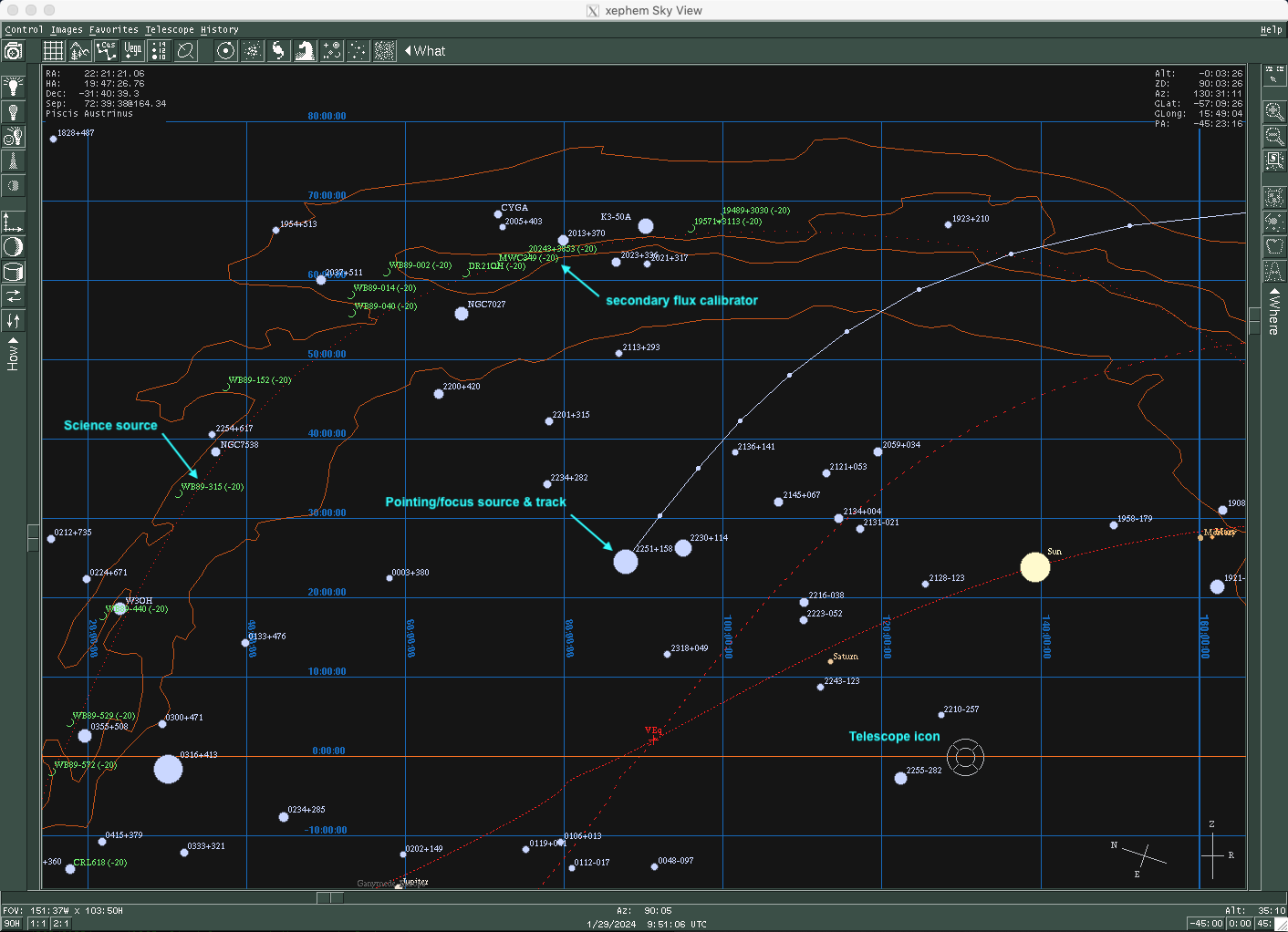
To load the sources catalog of your project, click on the tab "Data" and go to "Files". In the new window go again to "Files" and select the catalog of the project that you plan to observe.
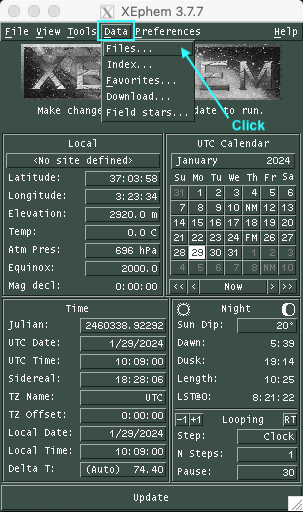

Ask the AoD or the Operator for further details.
Starting PIIC
PIIC is a quicklook (QL) monitor to process continuously the NIKA2 data. To start it, first ask the AoD to start the production of NIKA2-imbfits required to reduce the data with PIIC.
$ ssh -XY nikaw-23@mrt-lx3 $ cd ql $ gagpiic $ piic @monitorX
with X = 2pf, for 2 mm-pointing/focus monitoring only, and X = 1, 2m, 3, the instrument array to be monitored.
Starting the NIKA2 IDL pipeline
Optionally, to have the IDL pipeline continuously processing observations as they are produced, open a terminal and type:
$ ssh -XY observer@nika2-a (ask the AoD for the password) $ IDL IDL> nk_rta, scanID (e.g. '20201019s132')
where scanID is the corresponding identifier of the observation (as shown in the example) in the format YYYYMMDDsXXX, where YYYY is the year, MM the month, DD the day, and XXX the scan number.
Pointing
Under standard conditions, pointing corrections of the IRAM 30m telescope should be done every hour or a bit more with good stability (see below), except around dusk and dawn when more frequent pointing corrections may be necessary.
In order to correct the pointing of the telescope in a given part of the sky choose a nearby pointing source (using e.g. XEphem) and type:
PAKO> source 0133+476 /cat * (or "iram-J2000.sou" or "pointingIRAM30m.sou", or "CalibNIKA.sou" for secondary flux calibrators)
Now launch the nkpoint script:
PAKO> @ nkpoint mode
where the keyword "mode" can adopt the values b for bright sources and f for faint sources (the l option for very faint sources that require the Lissajous pattern is no longer used). To obtain the pointing corrections, use the results given by the 2pf PIIC monitor. Supplementarily, PIIC monitors 1 and 3 show the pointing corrections based on 1 mm data.
Alternatively, you can process the corresponding scan with the IDL pipeline: "IDL> nk_rta, scanID".
Once the pointing scan is processed, enter the new pointing corrections in azimuth (PnewX) and in elevation (PnewY) shown on the IDL prompt of the NIKA2 pipeline:
PAKO> set pointing PnewX PnewY
An example of PIIC-QL main plot of a standard pointing scan is shown in the following picture. Pointing correction, a proxy of the beam size (main-beam FWHM at 2 mm wavelength), and other data are highlighted:
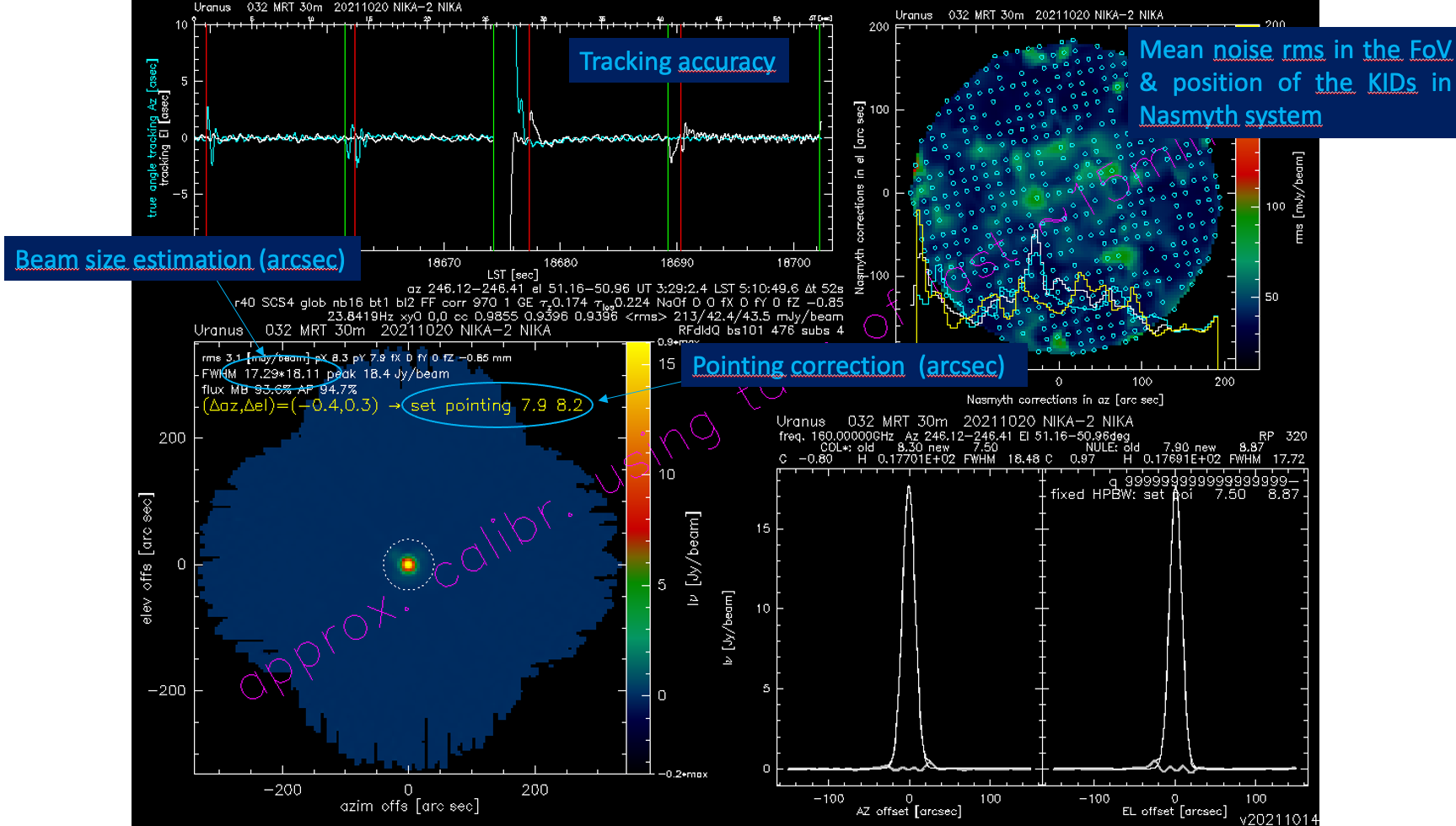
Focus
The focus needs to be monitored and it needs to be corrected online. This should be done every two hours or so (~3h during very stable night-time conditions, ~1h or less near sunrise and sunset) in the Z direction. To check the quality of the focus run:
PAKO> @ focusOTF-Z fz
Currently, this script will carry out 5 foci measurements in Z direction within a 1.6 mm range, centered at the fz value. Telescope focus for NIKA2 is currently around 0 to +1 mm in standard conditions. To obtain the focus corrections, use the results given by the 2pf PIIC-QL monitor. Supplementarily, PIIC-QL monitors 1 and 3 also show focus corrections from 1 mm data. It gives the best focus corrections from an order-2 fitting of the observed peak flux, and two different parameters from a 2d-gaussian fit of the source used for this purpose. Under expected conditions, these values should broadly converge. If this condition is not met, the average of the two mutually consistent values could be adopted as a focus correction. An example of a typical result of a focus sequence from the PIIC-QL monitor (2 mm) looks as follows:
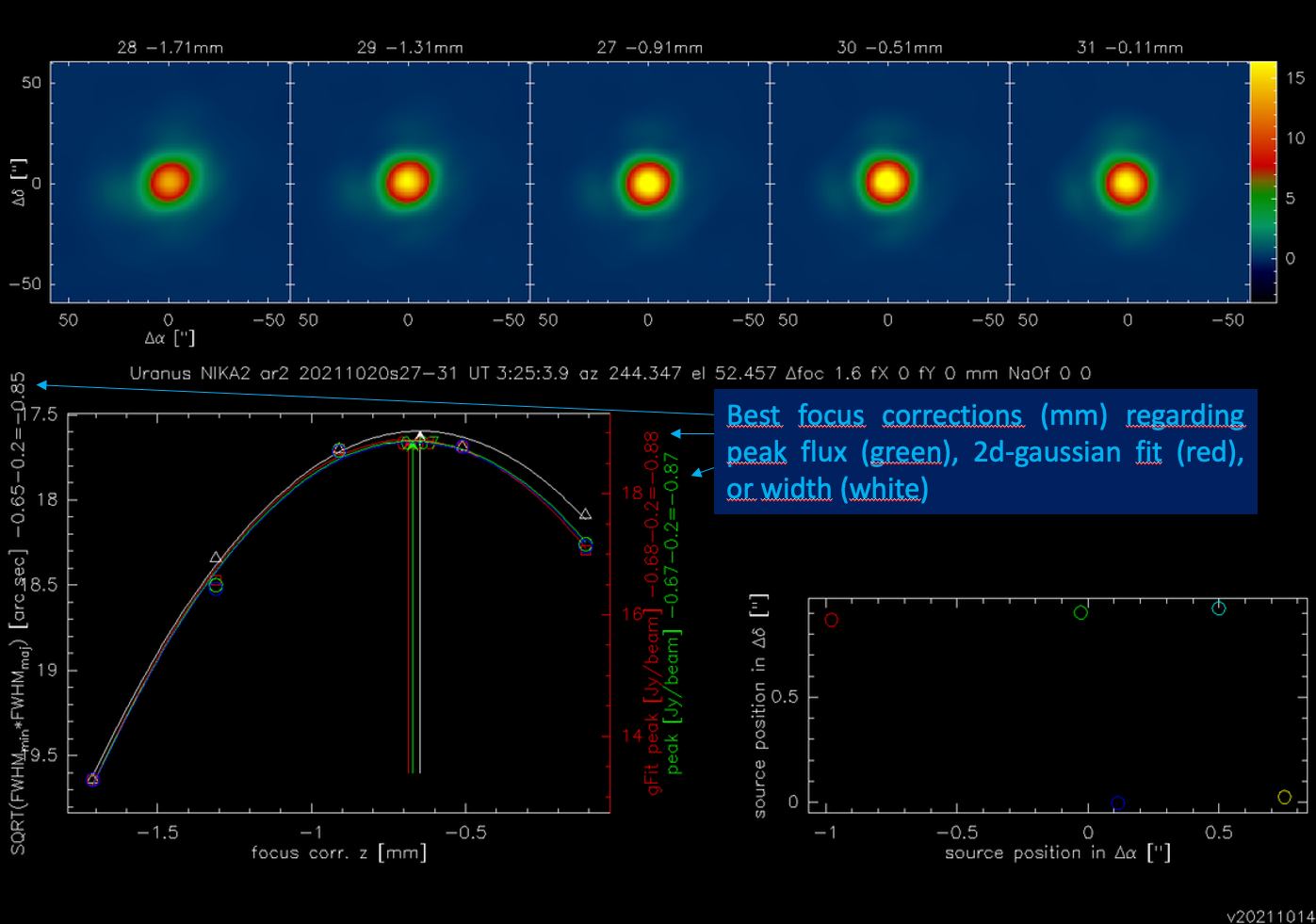
Alternatively, the corresponding scan number can be processed by the IDL pipeline:
IDL> nk_rta, scanID1 (for measurement 1) IDL> nk_rta, scanID2 (for measurement 2) IDL> nk_rta, scanID3 (for measurement 3) IDL> nk_rta, scanID4 (for measurement 4) IDL> nk_rta, scanID5 (for measurement 5)
Then, all measured foci need to be processed together by the "nk_focus_otf" routine of the IDL pipeline to perform the best focus fit in terms of the measured Flux, beam FWHM, and beam ellipticity of the KID's. This can be achieved by running the following instruction in the IDL prompt:
IDL> nk_focus_otf,'YYYYMMDDs'+strtrim(SCANNUMBER+indgen(5),2)
where the ScanID is in the format YYYYMMDDsSCANNUMBER (e.g. '20151019s132'). Once the "nk_focus_otf" routine has finished, check the focus correction values displayed in the IDL prompt under "Fluxes" for the three arrays (A1, A2, & A3) and calculate the average value that will be used to correct the focus. Enter the new focus value (Fnew) as follows:
PAKO> set focus Fnew
Beam map
This kind of scan is to be done once a day or every two days. It takes ~25 min, so to avoid accounting for the time spent on your project think about changing the project to:
PAKO> set project nikaw-23
Beam maps are designed to ensure the source is moved over all the detectors of the array, in order to characterize and calibrate them (field of view geometry, flat field, stability, etc). The aim is to calculate the actual pixel offsets in the focal plane (see figure below). To obtain a beam map go to a primary calibrator and launch the beammap1scan99sub.pako script in the normal PaKo session:
PAKO> @ beammap1scan99sub (to produce 99 sub-scans, standard PaKo version)
OPTION = a (ENTER OPTION: a = Az. scan, e = El. scan, l = lower than 60° in El., h = between 60° and 70° in El.)
W-OTFMAP /TOTF, value 12.0 implies /speed 65.0 outside standard range 0.0 to 60.0
W-OTFMAP, WARNING--CONDITION: Elevation must be less than 69.03 [deg]
OTFMAP 780''x 470.4'' (step 4.8)
> Number of subscans: 99
> Scanning speed: 65 arcsec/sec
> Time per subscan: 12 sec
> Execution time: 23.1 min 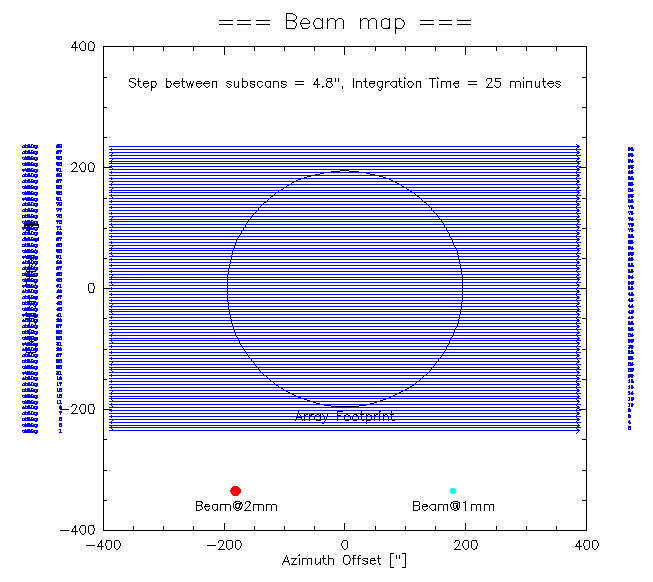
Don't forget to set back to your project once the beam map is done!
Skydips
This kind of scan is to be done two to four times a day. It takes ~6 min, so to avoid accounting for the time spent on your project think about changing the project to:
PAKO> set project nikaw-23
To run a skydip with NIKA2 type in PaKo:
PAKO> @ skydip
The script will perform 11 measurements (30 [s] tracks) at different airmasses wrt. the position Az = 180°, El = 55° in the HORIZON coordinate system. The skydip takes ~6.4 minutes to be finished.
Don't forget to set back to your project once the sky dip is done!
Science targets
Observations of science targets are performed via on-the-fly (OTF). Observers may want to scan only in Azimuth, as scan directions other than Azimuthal induce instabilities/drifts especially for NIKA2, and increased noise due to: change of airmass; reaction to telescope acceleration; coupling to electric/magnetic/acoustic signals.
In any case, the prepared scripts allow for a variety of scanning directions. For example, for a 10'x15' OTF map, with a position angle of 25 degrees, a tilt angle of 0 degrees (both measured anticlockwise), in equatorial coordinates (radec, for the HORIZON coordinate system set azel), just type:
PAKO> @nkotf 10 15 25 0 20 40 radec
This command will produce a scan pattern as follows:
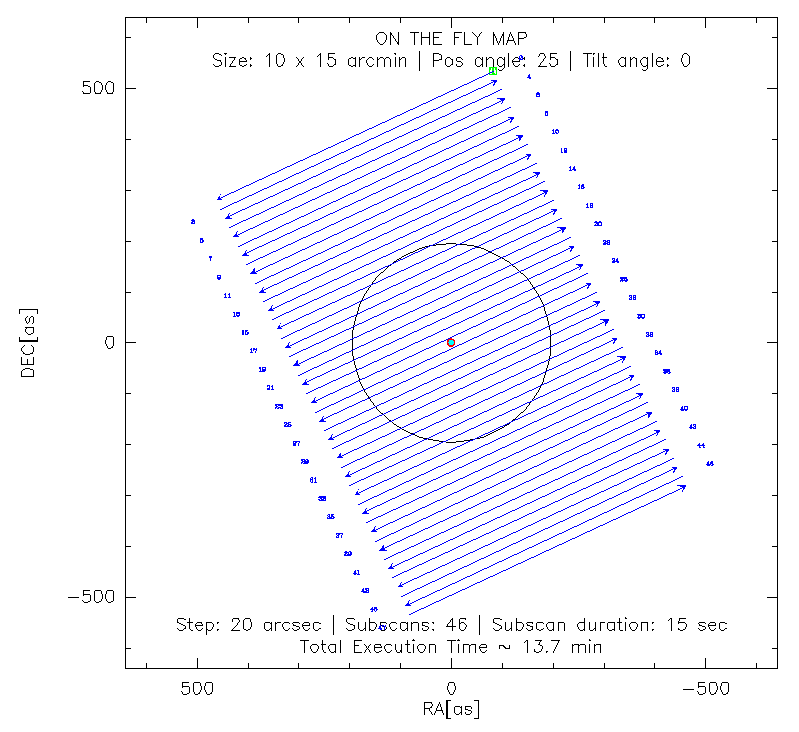
A sequence of several scans can be loaded using a script containing a sequence of nkotf maps. For example, the script observe_NGC4449.pako combines several 10'x15' OTF maps at different PA and tilt angles in the horizontal coordinate system (azel).
Note that in general, it is better to have the longer direction along the subscan to minimize the time loss due to overheads between subscans. Also for baseline subtraction in the data processing, it's always better to set a subscan length longer than the usable map you wish to have (typically ~1' more than the usable map; the optimal value depends on the map size and scanning speed). Scanning in azimuth is better for sky noise subtraction, but the best scanning strategy depends on your source shape and its az-el coverage during the integration time.
Contact: Angel Bongiovanni, Ioannis Myserlis, Stergios Amarantidis (NIKA2 NIKA2 Pool Management)
email: bongio@iram.es, imyserlis@iram.es, samarant@iram.es
Created: 2013.OCT.25, by Isreal Hermelo
Updated: 2017.FEB.05, by Pablo García
Updated: 2017.SEP.28, by Alessia Ritacco
Updated: 2017.OCT.23, by Samuel Leclercq
Updated: 2019.JAN.23, by Carsten Kramer
Last update: 2024.FEB.06, by Angel Bongiovanni
